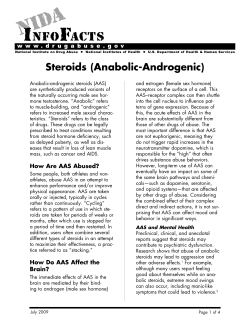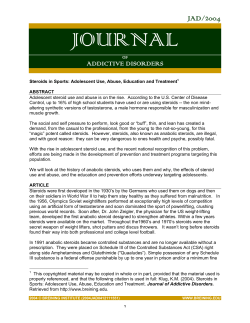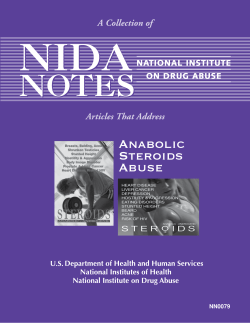
A Adolescents and Steroids: What Principals Should Know Student Services
Student Services Adolescents and Steroids: What Principals Should Know Understanding the factors that lead to steroid use will help principals implement effective prevention programs and interventions. By Sarita Gober, Paul C. McCabe, and Malky Klein A fter outbreaks of aggressive behavior among several members of the school’s football team, the principal of a suburban high school has become increasingly concerned. One student, Jason, had no history of behavior problems the previous year. However, he returned to school transformed, with a lot more muscle and attitude. Although the coach was pleased with Jason’s performance during the season, even he has expressed some concerns about Jason’s behavior on and off the field. He had also heard rumors that Jason may have been experimenting with steroids, so he expressed his concerns to the principal. Together, they engage the school support team to intervene with Jason and then to evaluate the scope of steroid use among other students. This scenario is not unique. Although steroid abuse is usually associated with professional athletes seeking to improve their competitive edge, it is also a dangerous form of substance abuse among adolescents. Both boys and girls, athletes and non-athletes, are susceptible, and the physical and psychological risks are significant. According to Monitoring the Future, a longterm national study on drug abuse in adolescents, the 2005 prevalence rates for steroid use were 1.2%, 1.8%, 2.6% for 8th-, 10th-, and 12th-grade boys and 0.9%, 0.7%, 0.4% for girls, respectively. Equally alarming from an education standpoint, between 1998 and 2003, the percentage of 12th-grade students who perceived steroids as risky and disapproved their use dropped from 68% to 55%, despite increased health warnings (Johnston, O’Malley, Bachman, & Schulenberg, 2006). Given the risks associated with steroids and their continued acceptance among adolescents, it is important that school administrators work with staff members to understand motivating factors related to abuse and be prepared to address external risks (mass media exposure and peer culture) and internal Sarita Gober and Malky Klein are graduate students in the graduate program in school psychology at Brooklyn College–CUNY. Paul C. McCabe is an associate professor in the graduate program in school psychology at Brooklyn College–CUNY. Student Services is produced in collaboration with the National Association of School Psychologists (NASP). Articles and related handouts can be downloaded at www.naspcenter.org/principals. risks (student self-concept and body image) and to implement prevention and intervention efforts that reduce steroid use among students. Steroid Use and Abuse Anabolic-androgenic steroids are synthetic derivatives of the male hormone testosterone. Steroids are legally available only by prescription to treat conditions that occur when the body produces abnormally low amounts of testosterone, such as delayed puberty, some types of impotence, and body-wasting diseases such as AIDS. Steroid use causes the body to retain nitrogen, which in combination with exercise, training, and high protein diets, promotes increased size and strength of muscles, improves endurance, and decreases recovery time between workouts. Physical changes and health risks. When excess testosterone from steroids is converted to estrogens, male users may experience breast enlargement and testicular atrophy. In the female body, anabolic steroids cause irreversible masculine effects, such as growing facial hair, deepening voice, clitoral hypertrophy, and male pattern baldness. Severe acne, increased libido, and adverse effects on the reproductive system also may occur. Steroids can affect growth and maturation because the artificially increased PL November 2006 11 Student Services level of sex hormones in adolescence can signal the bones to stop growing prematurely. Steroid abuse also is associated with renal problems; cardiovascular disease, including heart attack and strokes, even in athletes younger than 30 (NIDA, 2005); and potentially fatal liver conditions, including tumors, cysts, and elevations of certain enzymes. Emotional and behavioral risks. When misused, steroids can increase irritability, aggression, euphoria, energy, sexual arousal, paranoia, distractibility, forgetfulness, confusion, extreme egocentrism, cognitive rigidity, altered physical identity, feelings of superiority, and extreme mood changes. Steroid use has also been associated with high-risk behaviors, including poly-drug use (i.e., the use of illicit drugs, tobacco, and alcohol), sharing needles, driving while under the influence, carrying a gun, committing property damage, and increased sexual activity and unprotected sex (Miller et al., 2005). Some steroid abusers present a physical threat to themselves or others and suffer symptoms severe enough to impede normal social, school, and work functioning. Suicide risk from withdrawal. Depression and suicide risk can accompany withdrawal from steroid use. Many experts argue that adolescents are especially susceptible to negative effects from steroid withdrawal because they are particularly vulnerable to hormonal swings. National attention to this risk was increased by a rash of highly publicized accounts of young athletes committing suicide. They all had been using steroids prior to their deaths and committed suicide shortly after discontinuing steroid use. Congress held hearings on the issue in March 2005, helping to further raise awareness. Steroids and Adolescence It is clear that a great deal more information about steroids needs to be shared with young people; their Case Study During his freshman year, Jason was a good student with a low-key personality and an average build. He made second string on the varsity football team. When he returned for his sophomore year, everyone noticed that he had added muscle and was more confident and assertive. Jason worked hard in practice and spent hours in the weight room. Over time, though, Jason’s behavior became more erratic and aggressive. He became disrespectful in class and confrontational with his peers but denied that his behavior was excessive. Although he was pleased with Jason’s improved abilities, his coach repeatedly cautioned him about his behavior and notified the principal and Jason’s parents of his concerns. Jason’s parents, who had also noticed increasing defiance and changes in his appearance and habits, agreed to meet with the school support team. After discussing parent and staff member observations, the school psychologist suggested that Jason might be taking steroids. Jason eventually admitted to some use but argued that it was no big deal because he’d read about professional athletes who boosted their performance with steroids and he knew other students who used them. With the joint efforts of his parents, his doctor, the coach, and the school psychologist, Jason finally acknowledged that he was putting himself and potentially others at risk. Jason, like many adolescents, wanted to look like the young men pictured in his sports magazines and on TV. He knew about steroids from the media and started buying them through older students. Although he was initially thrilled with the changes in his physique and strength, he developed excessive acne and slightly enlarged breasts. He recognized that he was more prone to outbursts and aggression but attributed these changes to the provocations of others who envied of his appearance and abilities. Until he was confronted and given information about the effects of steroids, Jason was unaware of the connection between these physical and emotional changes and steroid use. Jason was probably addicted to steroids, physically and psychologically. He had emotional difficulty, reported feeling empty and depressed, and at one point contemplated suicide. The school psychologist recommended a specialist and arranged to work with Jason at school to provide extra support. With this support, Jason successfully stopped taking the drugs and continues working on building his self-esteem and self-confidence through individual counseling and group sessions. 12 PL November 2006 parents; and other adults—such as coaches and health teachers—who are in a position to influence adolescents’ choices about their bodies. Body image. Adolescents are strongly influenced by external factors when shaping their emerging self-image. They compare themselves to peers, media idols, and athletes and often define their self-image as a reflection of their physical attractiveness and athletic prowess. The “ideal” body image portrayed in the media—lean, with well-defined, sculpted large muscles—is often physically unattainable or can only be obtained through unhealthy practices such as steroid usage (Stout & Wiggins, 2004). While adolescent females are more likely to use diet, diet pills, and exercise—and may develop eating disorders—males are more likely to use steroids to achieve the desired physical appearance and to enhance strength (Field et al., 2005). Athletic performance. Adolescents are influenced by the actions of professional athletes who have used steroids to improve their athletic performance (Miller et al., 2005). In addition, almost all sports have become increasingly competitive at younger and younger ages. Research is limited on the physical and psychological implications of such intense competition so young. However, it is not unreasonable to expect that some adolescents may succumb to the pressure to continually push their bodies beyond what is naturally achievable. In addition, adolescents report misinformation about the effects and outcomes of steroid use, relying on friends and the media for information and believing the false information that steroids will improve their aerobic performance and increase their height. Many are unaware of the physical and psychological damage from steroid use (Tanner, Miller, & Alongi, 1995). Risk factors. Although athletes are clearly at risk for steroid use, some adolescents who are not involved in sports are also at risk (Field et al., 2005). In general, athletes are more likely to take steroids to improve their performance and non-athletes are more likely to take steroids to improve their appearance. However, neither athletic participation nor strength conditioning predicted greater odds of steroid use after controlling for problem behaviors (Miller et al., 2005). In fact, problem behaviors, such as substance use, fighting, and sexual risk-taking are better predictors of adolescent steroid use than participation in sports. Steroid users report lower self-esteem and greater depressed mood PL November 2006 13 Student Services than nonusers, which may perpetuate steroid usage (Irving, Wall, NeumarkSztainer, & Story, 2002). In fact, adolescents who feel depressed or inferior may take steroids because the steoids cause feelings of invincibility. This may create a psychological “double bind” effect where steroids mask feelings of inadequacy yet are exacerbating symptoms of depression and psychological disorder. Prevention and Intervention Drug testing. Efforts to prevent steroid abuse include legal sanction (distributing or possessing steroids without a valid prescription is a felony), drug testing, and education. Across the nation, administrators are struggling with the issue of drug testing. A number of school districts and lawmakers view randomized drug testing as a way to thwart steroid use. In New Jersey, beginning with the 2006–07 school year, a state executive order mandates random drug testing of students participating in championship tournaments. More than 50 school districts nationally have received Department of Education grants to initiate random drug testing of students in extracurricular activities. However, many administrators are wary of initiating random drug trials because of issues related to invasion of privacy, unreasonable searches, and the financial and political costs of doing so (LaFee, 2006). Prevention programs. Whether or not principals choose to employ drug testing as one deterrent, implementing comprehensive prevention and intervention programs is important. Such programs should target both adolescents using steroids to improve athletic performance and adolescents trying to improve their appearance. Informational programs that focus solely on the adverse side effects of steroids or use scare tactics have not proven especially effective (Goldberg, Bents, Bosworth, Trevisan, & Elliot, 1991). Instead, programs that raise awareness of the risks, decrease social anxiety, and increase self-esteem and positive selfbody image have yielded positive results (Nilsson, Allebeck, Marklund, Baigi, & Fridlund, 2004). Once such program funded by the National Institute on Drug Abuse, Athletes Training and Facts About Steroid Use • Males are 2 or 3 times more likely to use steroids than females. • Older students are more likely to be steroid users than younger students: the mean age of first use is 15 years. • Students who use steriods are more likely to participate in schoolsponsored athletics than non-users. • Sports requiring strength training, including body building, football, wrestling, and track and field, have more reported users than other sports. • Problem behaviors, such as substance use, fighting, and sexual risk-taking are better predictors of adolescent steroid use than participation in sports. Source: Bahrke, M. S., Yesalis, C. E., Kopstein, A.N., & Stephens, J. A. (2000). Risk factors associated with anabolic-androgenic steroid use among adolescents. Sports Medicine, 29, 395–405. 14 PL November 2006 Learning to Avoid Steroids (ATLAS), has been implemented in a number of schools and is reported to have reduced steroid use among more than 1,500 football players from 31 high schools in the Portland area (Goldberg, Bents, Bosworth, Trevisan, & Elliot, 1996). The program educates student athletes about the harmful effects of anabolic steroids and provides nutrition and weight-training alternatives to steroid use. In addition to the 10 45-minute classroom sessions, there are three exercise sessions for the weight room that teach the students proper weight training techniques. These sessions are designed to help student athletes build the muscular strength needed to achieve their athletic goals without using steroids. The Role of Administrators Choosing the most effective approach to prevention and intervention requires understanding the risks and needs of the student body. Administrators need to assess the profile of their student body’s specific needs, determine what environmental risks may be present in the school culture, and tailor the appropriate prevention and intervention program as necessary. Programs should: • Educate teachers, coaches, parents, and students about the adverse effects of anabolic steroids use • Identify appropriate referral sources for families of steroid users • Implement appropriate schoolwide or student-specific programs to prevent adolescents from using steroids • Implement appropriate schoolwide programs to intervene if steroids, or even risky dietary supplements, are being used by students • Establish clear rules about what kind of advice coaches and trainers can give Resources on the Web behaviors. Substance Use & Misuse, 40, ATLAS Program www.ohsu.edu/hpsm/atlas.html n National Institute on Drug Abuse. 1637–1657. Drug Rehab Programs www.drug-rehabs.com (2000). Research report series: Anabolic NIDA Steroid Abuse Site www.steroidabuse.org steroid abuse (NIH Publication No. 00- U.S. Department of Justice 3721). Bethesda, MD.: National Institute on www.deadiversion.usdoj.gov/pubs/brochures/steroids Drug Abuse. to students who wish to enhance their bodies and athletic performance • Create an atmosphere of openness, team cooperation, and ethical responsibility in sporting activities, rather than cutthroat competition that may lead some students to desperate means of staying competitive • Identify and intervene with students who may be suffering from depression and self-image problems and therefore more likely to engage in high-risk behaviors. PL n Nilsson, S., Allebeck, P., Marklund, B., Monitoring the Future: National results Baigi, A., Fridlund, B. (2004). Evaluation of on adolescent drug use. Overview of key a health promotion programme to prevent findings, 2005 (NIH Publication No.06- the misuse of androgenic anabolic steroids 5882). Bethesda, MD: National Institute among Swedish adolescents. Health Promo- on Drug Abuse. tion International, 19(1), 61–67. n LaFee, S. (2006, June). Steroids: To test n Stout, E. J., & Wiggins, M. (2004). or to educate? The School Administrator, 63. Body image disorder in adolescent males: Retrieved July 12, 2006 from http://www Strategies for school counselors. Professional .aasa.org/publications/saissuedetail.cfm?Ite School Counseling, 8(2), 176–181. mNumber=6312&snItemNumber=950 n Tanner, S. M., Miller D. W., & Alongi, C. n Miller, K. E., Hoffman, J. H., Barnes, G. (1995). Anabolic steroid use by adolescents: M., Sabo, D., Melnick, M. J., & Farrell, M. prevalence, motives, and knowledge of risks. P. (2005). Adolescent anabolic steroid use, Clinical Journal of Sport Medicine, 5(2), gender, physical activity, and other problem 108–115. References n Field, A. E., Austin, S. B., Camargo, C. A., Taylor, C. B., Striegel-Moore, R. H., Loud, K. J. et al. (2005). Exposure to the mass media, body shape concerns, and use of supplements to improve weight and shape among male and female adolescents. Pediatrics, 116(2), 214–220. n Goldberg, L., Bents, R., Bosworth, E., Trevisan, L., & Elliot, D. (1991). Anabolic steroid education and adolescent: Do scare tactics work? Pediatrics, 87(3), 283–286. n Goldberg, L., Elliot, D. L., Clarke, G., MacKinnon, D. P., Moe, E., Zoref, L., et al. (1996). Effects of a multidimensional anabolic steroid prevention intervention: The Adolescents Training and Learning to Avoid Steroids (ATLAS) Program. Journal of the American Medical Association, 276, 1555–1562. n Irving, L. M., Wall, M., Neumark-Sztainer, D., & Story, M. (2002). Steroid use among adolescents: Findings from Project EAT. Journal of Adolescent Health, 30, 243–252. n Johnston, L. D., O’Malley, P. M., Bachman, J. G., & Schulenberg, J. E. (2006). PL November 2006 15
© Copyright 2025








![” ⊙ Prohibited Substances [1] Anabolic-Androgenic Steroids](http://cdn1.abcdocz.com/store/data/000006330_2-6488874179c020189ebf4ca4aba01440-250x500.png)












